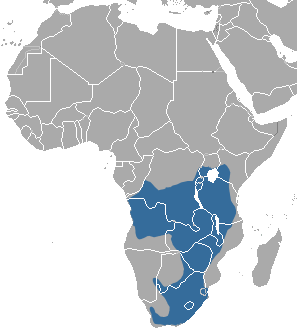African striped weasel facts for kids
Quick facts for kids African striped weasel |
|
|---|---|
 |
|
| In Omaha's Henry Doorly Zoo and Aquarium, Nebraska | |
| Conservation status | |
| Scientific classification | |
| Genus: |
Poecilogale
|
| Species: |
albinucha
|
 |
|
| African striped weasel range | |
The African striped weasel (Poecilogale albinucha) is a small, black and white weasel. It is the only species in its group, called Poecilogale. These weasels live in sub-Saharan Africa, which is the part of Africa south of the Sahara Desert.
Contents
About the African Striped Weasel
The African striped weasel is one of the smallest meat-eating mammals in Africa. It has a long body and short legs. Adult weasels are about 27 to 32 centimeters (11 to 13 inches) long from head to body. Their tail adds another 16 to 20 centimeters (6 to 8 inches) to their length.
Male weasels are bigger than females. Males weigh about 339 grams (12 ounces), while females weigh around 251 grams (9 ounces). Their fur is mostly black. They have four white or pale yellow stripes running down their back. They also have a white patch on top of their head and a white tail.
Physical Features
The weasel's head is long, with small eyes and a short, wide nose. Its ears are also short. Their teeth are sharp, especially their long canine teeth. Their claws are sharp and curved, which helps them dig. The tail is long and bushy.
Female weasels usually have four teats, which are used for feeding their young. Like many other animals in the weasel family, they have special scent glands. These glands can spray a bad-smelling liquid when the weasel feels scared or threatened. This is a way they protect themselves.
Where They Live
African striped weasels live in many parts of Africa south of the equator. You can find them from the Democratic Republic of the Congo all the way to Kenya in the north. They also live as far south as South Africa.
Habitat
These weasels are most often found in savannahs. Savannahs are grasslands with scattered trees. However, they can also live in forests and other grassy areas. They usually live in places that are below 1,500 meters (4,900 feet) high. Sometimes, they can be found in higher places, up to 2,200 meters (7,200 feet).
Weasel Behavior
African striped weasels hunt mostly at night. They look for small mammals, birds, and reptiles. They especially love to eat rodents, like mice, that are their own size or smaller.
Hunting and Food Storage
Weasels use their strong sense of smell to find prey. When they find something to eat, they lunge at it quickly. They aim for the back of the neck. After the first attack, they use their thin, strong bodies to whip and kick the prey. This helps them stun and tear it apart. Sometimes, they don't eat their prey right away. Instead, they store it in their burrow for later.
Social Life and Homes
African striped weasels usually live alone. But sometimes, a male and female might work together to dig burrows. They are very good at digging. If they can't dig a burrow, they might rest in natural spots. These can be hollow logs or cracks in rocks.
Weasels have special places where they go to the bathroom. These are called latrines. They might use these spots to leave their scent, which tells other weasels they are there.
Weasel Communication
Male weasels can be aggressive when they meet other males. First, they might fluff up their tails and make short cries. They might also make fake charges. If neither weasel backs down, they will start fighting. They bite, shake, and make loud, angry shrieks.
African striped weasels make six different sounds. Besides the warning and aggressive calls, they have a call that shows a male is giving up. Another call means surrender during a fight. There is also a greeting call, but it is only used between males and females, or between young weasels and their mother. Young weasels also make special calls if they get lost from their mother.
Weasel Babies
African striped weasels usually mate between spring and summer. The female will have one litter of two or three babies. The babies are born about 30 days after mating.
Growing Up
The young weasels are born in a burrow. They are born blind and without fur. Each baby weighs only about 4 grams (0.14 ounces). Their canine teeth start to grow when they are 5 weeks old. Their eyes open when they are 7 weeks old.
By 11 weeks of age, they stop drinking their mother's milk. They start to hunt and kill their own prey at 13 weeks. They reach their full adult size when they are 20 weeks old. They can have their own babies when they are about 8 months old.
What They Eat
African striped weasels mainly eat mice and other small rodents. They also sometimes eat birds and bird eggs.


